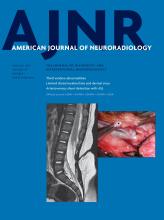Index by author
Lapergue, B.
- INTERVENTIONALYou have accessImpact of Modified TICI 3 versus Modified TICI 2b Reperfusion Score to Predict Good Outcome following Endovascular TherapyC. Dargazanli, A. Consoli, M. Barral, J. Labreuche, H. Redjem, G. Ciccio, S. Smajda, J.P. Desilles, G. Taylor, C. Preda, O. Coskun, G. Rodesch, M. Piotin, R. Blanc and B. LapergueAmerican Journal of Neuroradiology January 2017, 38 (1) 90-96; DOI: https://doi.org/10.3174/ajnr.A4968
Lau, C.S.
- ADULT BRAINYou have accessStructural Brain Network Reorganization in Patients with Neuropsychiatric Systemic Lupus ErythematosusX. Xu, E.S. Hui, M.Y. Mok, J. Jian, C.S. Lau and H.K.F. MakAmerican Journal of Neuroradiology January 2017, 38 (1) 64-70; DOI: https://doi.org/10.3174/ajnr.A4947
Leclerc, X.
- FELLOWS' JOURNAL CLUBADULT BRAINYou have accessIntracranial Arteriovenous Shunting: Detection with Arterial Spin-Labeling and Susceptibility-Weighted Imaging CombinedJ. Hodel, X. Leclerc, E. Kalsoum, M. Zuber, R. Tamazyan, M.A. Benadjaoud, J.-P. Pruvo, M. Piotin, H. Baharvahdat, M. Zins and R. BlancAmerican Journal of Neuroradiology January 2017, 38 (1) 71-76; DOI: https://doi.org/10.3174/ajnr.A4961
Ninety-two consecutive patients with a known (n = 24) or suspected arteriovenous shunting (n = 68) underwent DSA and brain MR imaging, including arterial spin-labeling/SWI and conventional angiographic MR imaging. DSA showed arteriovenous shunting in 63 of the 92 patients. Interobserver agreement was excellent. In 5 patients, arterial spin-labeling/SWI correctly detected arteriovenous shunting, while the conventional angiographic MR imaging did not. The authors conclude that the combined use of arterial spin-labeling and SWI may be an alternative to contrast-enhanced MRA for the detection of intracranial arteriovenous shunting.
Lee, C.-C.J.
- INTERVENTIONALYou have accessQuantifying the Cerebral Hemodynamics of Dural Arteriovenous Fistula in Transverse Sigmoid Sinus Complicated by Sinus Stenosis: A Retrospective Cohort StudyW.-Y. Guo, C.-C.J. Lee, C.-J. Lin, H.-C. Yang, H.-M. Wu, C.-C. Wu, W.-Y. Chung and K.-D. LiuAmerican Journal of Neuroradiology January 2017, 38 (1) 132-138; DOI: https://doi.org/10.3174/ajnr.A4960
Lee, J.H.
- HEAD & NECKYou have accessPerformance of CT in the Preoperative Diagnosis of Cervical Lymph Node Metastasis in Patients with Papillary Thyroid Cancer: A Systematic Review and Meta-AnalysisC.H. Suh, J.H. Baek, Y.J. Choi and J.H. LeeAmerican Journal of Neuroradiology January 2017, 38 (1) 154-161; DOI: https://doi.org/10.3174/ajnr.A4967
Lee, J.Y.
- EDITOR'S CHOICEPEDIATRICSYou have accessLimited Dorsal Myeloschisis and Congenital Dermal Sinus: Comparison of Clinical and MR Imaging FeaturesS.M. Lee, J.-E. Cheon, Y.H. Choi, I.-O. Kim, W.S. Kim, H.-H. Cho, J.Y. Lee and K.-C. WangAmerican Journal of Neuroradiology January 2017, 38 (1) 176-182; DOI: https://doi.org/10.3174/ajnr.A4958
These investigators retrospectively reviewed the clinical and MR imaging findings of 12 patients with limited dorsal myeloschisis and 10 patients with congenital dermal sinus. A crater covered with pale epithelium was the most common skin lesion in limited dorsal myeloschisis (83%). Infectious complications were common in congenital dermal sinus (60%), but not found in limited dorsal myeloschisis. They show that limited dorsal myeloschisis has distinct MR imaging features including a visible intrathecal tract with dorsal tenting of the cord at the tract-cord union.
Lee, S.M.
- EDITOR'S CHOICEPEDIATRICSYou have accessLimited Dorsal Myeloschisis and Congenital Dermal Sinus: Comparison of Clinical and MR Imaging FeaturesS.M. Lee, J.-E. Cheon, Y.H. Choi, I.-O. Kim, W.S. Kim, H.-H. Cho, J.Y. Lee and K.-C. WangAmerican Journal of Neuroradiology January 2017, 38 (1) 176-182; DOI: https://doi.org/10.3174/ajnr.A4958
These investigators retrospectively reviewed the clinical and MR imaging findings of 12 patients with limited dorsal myeloschisis and 10 patients with congenital dermal sinus. A crater covered with pale epithelium was the most common skin lesion in limited dorsal myeloschisis (83%). Infectious complications were common in congenital dermal sinus (60%), but not found in limited dorsal myeloschisis. They show that limited dorsal myeloschisis has distinct MR imaging features including a visible intrathecal tract with dorsal tenting of the cord at the tract-cord union.
Liebeskind, D.S.
- FELLOWS' JOURNAL CLUBINTERVENTIONALOpen AccessEndovascular Therapy of M2 Occlusion in IMS III: Role of M2 Segment Definition and Location on Clinical and Revascularization OutcomesT.A. Tomsick, J. Carrozzella, L. Foster, M.D. Hill, R. von Kummer, M. Goyal, A.M. Demchuk, P. Khatri, Y. Palesch, J.P. Broderick, S.D. Yeatts, D.S. Liebeskind and for the IMS III InvestigatorsAmerican Journal of Neuroradiology January 2017, 38 (1) 84-89; DOI: https://doi.org/10.3174/ajnr.A4979
The authors reviewed the impact of revascularization on clinical outcomes in 83 patients with M2 occlusions in the Interventional Management of Stroke III trial according to specific M1–M2 segment anatomic features. AnmRS 0–2 outcome was associated with reperfusion for M2 trunk (n = 9) or M2 division (n = 42) occlusions, but not for M2 branch occlusions (n = 28). Of the 83 participants with M2 occlusion who underwent endovascular therapy, 41.0% achieved mRS 0–2 at 90 days, including 46.6% with modified TICI 2–3 reperfusion compared with 26.1% with modified TICI 0–1 reperfusion. They conclude that mRS 0–2 at 90 days was dependent on reperfusion for M2 trunk but not for M2 branch occlusions in IMS III.
Lin, C.-J.
- INTERVENTIONALYou have accessQuantifying the Cerebral Hemodynamics of Dural Arteriovenous Fistula in Transverse Sigmoid Sinus Complicated by Sinus Stenosis: A Retrospective Cohort StudyW.-Y. Guo, C.-C.J. Lee, C.-J. Lin, H.-C. Yang, H.-M. Wu, C.-C. Wu, W.-Y. Chung and K.-D. LiuAmerican Journal of Neuroradiology January 2017, 38 (1) 132-138; DOI: https://doi.org/10.3174/ajnr.A4960
Lin, J.
- ADULT BRAINOpen AccessMeasuring Brain Tissue Integrity during 4 Years Using Diffusion Tensor ImagingD. Ontaneda, K. Sakaie, J. Lin, X.-F. Wang, M.J. Lowe, M.D. Phillips and R.J. FoxAmerican Journal of Neuroradiology January 2017, 38 (1) 31-38; DOI: https://doi.org/10.3174/ajnr.A4946








